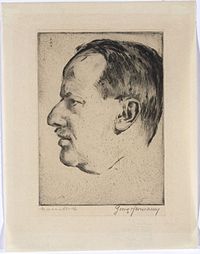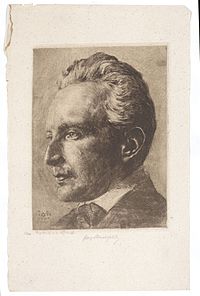Hermann Struck (painter)
Hermann Struck (with Hebrew name Chaim Aharon ben David ; born March 6, 1876 in Berlin ; † January 11, 1944 in Haifa ) was a German-Jewish draftsman , painter , etcher and lithographer .
Life
Hermann Struck, son of the Berlin businessman David Struck and Henriette Hanff, received his training at the Berlin Art Academy , which he passed with flying colors. Struck became a respected draftsman, lithographer and etcher in Berlin society around the turn of the century. His name can be found in the list of members of the German Association of Artists as early as 1906 . Not only did he teach many artists the subtleties of his arts, but he was also an often consulted advisor on many artistic and social issues. For the many visits by artists, poets, theater people, musicians, journalists, scientists and rabbis, he set up his own meeting rooms in his studio.
During the First World War , he served as a consultant for Jewish affairs at the High Command East of the German Army in those parts of the Russian Empire that are now Poland , Lithuania , Latvia and Belarus . The book Das Ostjüdische Antlitz arose from an encounter with Arnold Zweig in Lithuania (1915) . He had a lively exchange with his artist colleague Ernst Oppler , and a total of 43 letters have been preserved in the estate.
As an Orthodox Jew and committed Zionist , he was one of the founders of the Misrachi movement of religious Zionism. After a first visit in 1903 , he emigrated to Palestine in 1923 , became a member of the Bezalel Academy for Art and Design in Jerusalem and helped found the Tel Aviv Museum of Art . His great commitment to art in Israel, which in addition to the founding of the museum in Tel Aviv and an art school in Jerusalem also included the establishment of an artists' colony in Haifa, earned him widespread admiration as "the artistic soul of Israel".
plant
















Struck is particularly known for his etchings and lithographs . Struck had a particular influence on the art world around the turn of the century, when his prints had a decisive influence on graphic art in Germany. His book The Art of Etching (1908) is still considered a standard work today and was a work of great influence in its epoch. Struck taught among others Marc Chagall , Max Liebermann , Max Slevogt , Lovis Corinth , Joseph Budko and Lesser Ury in the art of etching and lithography.
He created portraits of Henrik Ibsen , Friedrich Nietzsche , Sigmund Freud , Albert Einstein , Theodor Herzl , August Bebel , Alfred Kerr , Richard Dehmel , Hermann Cohen , Gerhart Hauptmann , Arnold Zweig and Oscar Wilde , among others .
A selection of these can be viewed in the Hermann Struck exhibition at the Museum of German-speaking Judaism in Tefen in northern Israel. There is also a room with items from Struck's possession. The Jewish Museum Frankfurt dedicated an exhibition to the etchings and woodcuts by Struck and his artist colleague Jakob Steinhardt from December 2014 to March 2015. In this exhibition, the focus was on his works from trips to Italy (1911), America (1912/13) and his stays in Poland and Russia during the First World War.
Publications
- The art of etching. A manual. Paul Cassirer, Berlin 1908. 4th edition 1920 ( archive.org ); 5th edition 1923 with the assistance of Karl Schwarz .
Books with illustrations by Hermann Struck
- Hermann Struck, Herbert Eulenberg : Sketches from Lithuania, Belarus and Courland. 60 stone drawings. Georg Stilke, Berlin 1916 ( archive.org ).
- Felix von Luschan : Prisoners of War. A contribution to ethnology in the world war. With 60 text illustrations and 100 original lithographs by Hermann Struck. Reimer, Berlin 1917.
- Arnold Zweig : The Eastern Jewish Face. Fifty-two drawings by Hermann Struck. Welt-Verlag, Berlin 1920 ( uni-frankfurt.de ).
- Salman Schneur: Vilna. Hasefer, Berlin-Charlottenburg 1924.
literature
- G. Kutna: Hermann Struck. In: East and West . 2nd year (1902), issue 1, columns 25-36 ( uni-frankfurt.de ).
- Arnold Fortlage, Karl Schwarz: The graphic work of Hermann Struck. With four original etchings. Paul Cassirer, Berlin 1911.
- Adolph Donath : Herman Struck. Publishing house for Jewish art and culture, Fritz Gurlitt, Berlin 1920 ( uni-frankfurt.de ).
- Georg Brandes: Heinrich Heine. With two etchings by Hermann Struck (portrait of Heinrich Heine, Heine's grave). Hofmann & Campe, Hamburg, Berlin 1922.
- Struck, Hermann . In: Hans Vollmer (Hrsg.): General lexicon of fine artists from antiquity to the present . Founded by Ulrich Thieme and Felix Becker . tape 32 : Stephens – Theodotos . EA Seemann, Leipzig 1938, p. 211-212 .
- John F. Oppenheimer (Red.) And a .: Lexicon of Judaism. 2nd Edition. Bertelsmann Lexikon Verlag, Gütersloh u. a. 1971, ISBN 3-570-05964-2 , col. 284.
- Jane Rusel: Hermann Struck (1876-1944). The life and graphic work of a Jewish artist (= Judaism and the environment. Volume 66). Peter Lang, Frankfurt am Main a. a. 1997 ( complete catalog raisonné of prints ).
- Claus Stephani : The image of the Jew in modern painting. An introduction. / Imaginea evreului în pictura modernă. Introductiv study. Bilingual edition (Romanian / German). Editura Hasefer, Bucharest 2005, ISBN 973-630-091-9 .
- Bernd-Ingo Friedrich : Venetian nights and dreams. A German anthology and eight Jewish nightmares. In: Marginalia. Journal of book art and bibliophilia. ISSN 0025-2948 . Issue 223 (4.2016), pp. 72-77.
Web links
- Literature by and about Hermann Struck in the catalog of the German National Library
- Illustrations by Hermann Struck in the holdings of the digital collections of the Frankfurt University Library
- Biography in English
- Arnold Zweig and Hermann Struck
- The Eastern Jewish face
- Partial estate in the Bavarian State Library
- Permanent exhibition on Struck in the Museum of German-speaking Judaism Tefen
- Works by Hermann Struck in the holdings of the Jewish Museum Berlin
- Literature by and about Hermann Struck in the library of the Jewish Museum Berlin
Individual evidence
- ↑ s. List of members in the catalog of the 3rd German Association of Artists Exhibition. Weimar 1906. p. 57 ( Textarchiv - Internet Archive ).
- ↑ Gilya Gerda Schmidt: The Art and Artists of the Fifth Zionist Congress, 1901: Heralds of a New Age . University Press, Syracuse, N.Y. 2003, ISBN 0-8156-3030-1 , pp. 88 (English, books.google.de ).
- ↑ Between Berlin and Haifa - an instance of the art of etching . In: Berliner Zeitung . August 1, 2007. Retrieved November 5, 2015. ( Page no longer available , search in web archives )
- ↑ omuseums.org.il
- ↑ Earlier temporary exhibitions, Hermann Struck and Jakob Steinhardt. Etchings and woodcuts . Jewish Museum Frankfurt . November 5, 2015. Retrieved November 5, 2015.
| personal data | |
|---|---|
| SURNAME | Struck, Hermann |
| ALTERNATIVE NAMES | Chaim Aaron ben David (real name) |
| BRIEF DESCRIPTION | German painter, etcher and lithographer |
| DATE OF BIRTH | March 6, 1876 |
| PLACE OF BIRTH | Berlin |
| DATE OF DEATH | January 11, 1944 |
| Place of death | Haifa |


